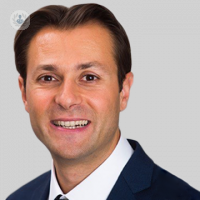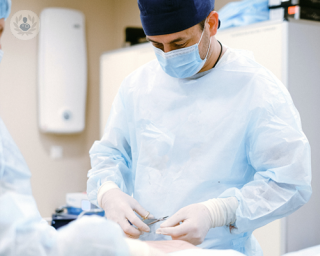Umbilical hernia
Mr Stefano Giuliani - Paediatric surgery
Created on: 11-13-2012
Updated on: 04-05-2023
Edited by: Conor Lynch
What is an umbilical hernia?
An umbilical hernia is a type of hernia that can be defined as parts of the internal organs protruding through a weakness in the surrounding cavity. In the case of an umbilical hernia, abdominal fat or part of the bowel passes through an area around the navel.

What are the symptoms of an umbilical hernia?
Umbilical hernias are very common, particularly in babies, and are characterised by a bulge around the navel that might get bigger when laughing or coughing. They are usually painless in infants and children, however, in adults that develop an umbilical hernia, the swelling may also be accompanied by pain and discomfort.
What causes an umbilical hernia?
An umbilical hernia develops as a result of a weakness in the abdominal wall at the navel. If the hole through which the umbilical cord passes through during pregnancy doesn’t close properly after birth, it can cause a hernia either at birth or later on in life. In adults, too much pressure in the abdominal cavity can increase the possibility of an umbilical hernia.
How can an umbilical hernia be prevented?
There is little that can be done to prevent umbilical hernias at birth. However, there are certain risk factors for adults. Anything that increases pressure in the abdominal cavity, such as obesity, straining while moving or lifting heavy objects, a persistent heavy cough, ascites (fluid in the abdomen), and having multiple pregnancies (i.e. twins, triplets, etc.), can increase the risk of an umbilical hernia.
What treatment is available for an umbilical hernia?
In infants, an umbilical hernia very often clears up on its own – the hernia goes back in and the muscle reseals over it. In adults, an umbilical hernia will generally get worse over time. In most cases, it is advised to wait until a child has reached four of five years of age to see if the hernia disappears before considering surgery, except in cases where the hernia is very large or there are other complications.
In most adults, umbilical hernias are treated with surgery to push the abdominal tissue back into place and seal the abdominal wall. Complications can include obstruction (where a section of bowel gets stuck outside the abdomen and can cause nausea, vomiting and pain and discomfort) as well as strangulation, whereby the blood supply to the section of bowel forming the hernia is cut off, a potentially serious complication which needs emergency treatment to prevent the trapped tissue from dying.
When is an umbilical hernia repair required?
Surgery to repair an umbilical hernia is usually recommended when the patient's hernia is causing extreme pain or discomfort, and/or persistent and severe symptoms. Surgery is a must when complications such as strangulation and/or obstruction occur.

How is this repair generally performed?
An umbilical hernia can either be repaired via open surgery or laparoscopically (minimally invasive). In terms of repairing an inguinal hernia through open surgery, a cut is made in order to help the surgeon push the lump back into the abdomen area. When it comes to a laparoscopic inguinal hernia repair, several small cuts are inserted and the surgeon uses various surgical instruments to repair the inguinal hernia.
Can an umbilical hernia heal without surgery?
As mentioned previously, an inguinal hernia typically heals on its own when experienced by children. Adults, however, will almost always require surgery, as this is the only definitive treatment for inguinal hernias.
Which specialist treats umbilical hernias?
General practitioners and general surgeons are experts when it comes to treating all types of hernia, including umbilical hernias.















